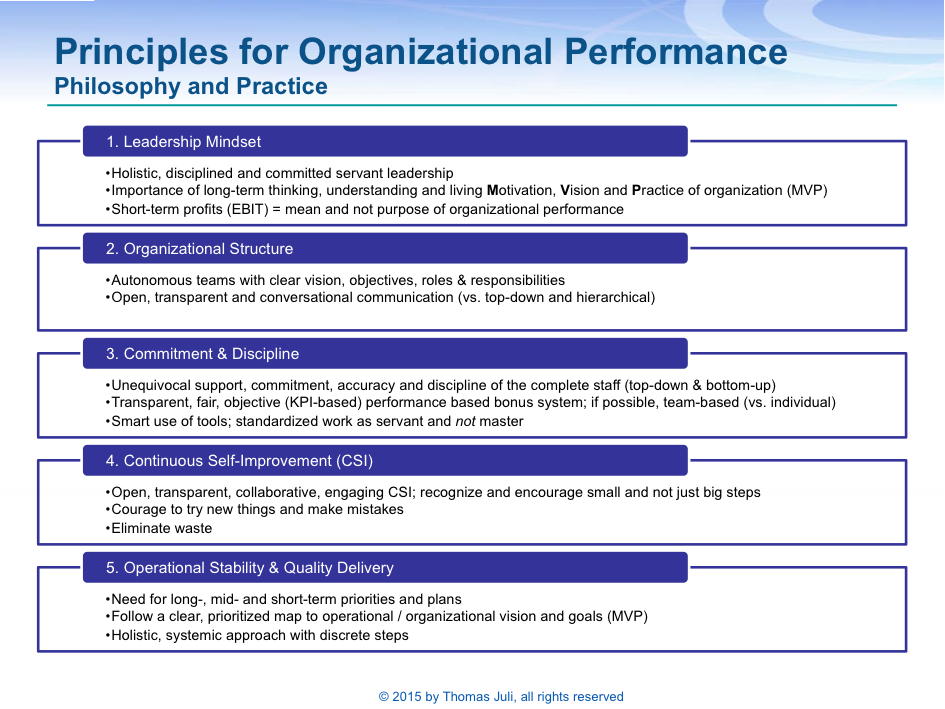Principles for Organizational Performance
In my last blog post I explained that organizational performance and excellence requires strong leadership with a particular mindset to prosper. What does this mean? There are 5 principles that provide guidance for this philosophy and practice to emerge.
- Leadership Mindset
- Organizational Structure
- Commitment & Discipline
- Continuous Self-Improvement (CSI)
- Operational Stability & Quality Delivery
(1) Leadership Mindset
You can use tools, technology, approaches, etc. for a given purpose. However, if your heart is not in it, it is not only inauthentic but your practice remains hollow and an empty shell. Organizational performance and excellence requires a holistic, disciplined and committed servant leadership style. Holistic leadership in this sense means that all four drivers of organizational excellence are understood, supported and practiced day in, day out. Disciplined and committed leadership means that it is understood that organizational excellence and performance takes time to develop. Corollary, leadership understands the importance of long-term thinking. It knows the motivation of the organization and where it comes from, it has a deep understanding and appreciation of its customers and their needs. Based on this motivation leadership helps develop a vision for the organization as a whole and secures common understanding and support of this vision. The vision serves as guidance and orientation for everyone working in and for the organization. It thus helps people derive concrete long-, mid- and short-term goals and practices for the organization.
I call the interacting balance of motivation, vision and practices of an organization the MVP of an organization. It is crucial for organizational performance and excellence to develop that leadership knows, supports and communicates the MVP of the organization. The MVP of the organization help put short-term goals into perspective. No doubt, quarterly results are important. But they have to be seen into perspective. Not short-term profits (EBIT) are the drivers of business but the health of the organization which encompass its clients, people and the business as a whole.
(2) Organizational Structure
Last year I conducted a workshop for an organization where the leadership team told me that their employees were complaining about a heavy workload, resulting overtime and a deteriorating work-life balance. I was asked to conduct a ‘Happy Workplace Workshop’ to develop mitigation activities. (I will explain the setup of such a ‘Happy Workplace Workshop’ in a future post.) The results were surprising: It was not really the workload that caused the addressed issues. It was the structure of the teams and collaboration rules that caused the imbalances. While individuals more or less knew their specific responsibilities, the teams lacked a clear vision and common goals. There were no standard procedures for synchronizing the efforts in and between teams. This lead to inefficiencies, redundancies and overtime.
Together the workshop participants revisited the organization’s motivation, vision and practices and found ways to translate them for their own realm of work. Roles and responsibilities were qualified and adjusted to the needs of the customers and the teams. Rules for open, transparent and conversational communication were defined and confirmed by management. – Within 3 weeks following the workshop the issues of a heavy workload, resulting overtime and a deteriorating work-life balance ceased to exist. Interestingly, it was not management that came up with these changes. It were the teams themselves that developed and realized relevant mitigations.
The workshop clarified that it is important to build and nurture autonomous teams with clear, commonly understood and supported vision and goals, roles and responsibilities. Communication in and between teams has to be open, transparent and conversational (vs. top-down and hierarchical).
(3) Commitment & Discipline
Leadership is not limited to one or two people “at the top” of an organization. Leadership can be practiced by everyone regardless of his or her role. On this token the principles for organizational performance ought to be understood, supported and committed by the complete staff. This requires discipline on all organizational levels. There is no textbook for practicing the principles in a precisely defined way. Principles serve as guidelines and orientation. Rather than following a strict procedure, encourage sharing of practical experiences of the principles in form of personal stories so that people can relate to them in their daily work.
Performance merits recognition. Some organizations have a bonus system in place. This can work and promote organizational performance as long as it is transparent, fair and objective. For example, it can be based on commonly defined key performance indicators (KPI’s). Since teamwork is crucial in more or less every modern organization team performance should be rewarded (vs. individual performance in a group). This fosters team spirit and accountability.
Processes, tools, procedures and policies can make work runs smoother. But, and this is a big BUT, they are only tools and serve a purpose. In other words, make smart use of them. It doesn’t add value to use a tool for the sake of the tool. Standardized work can be a great help and serve to make work more efficient and productive yielding better quality and hence value. However, standardized work, too, is just a tool and hence should remain a servant and not become a master.
(4) Continuous Self-Improvement (CSI)
It is funny and frustrating at the same time, when companies claim to be innovative; yet, when you talk with employees they tell you that mistakes are punished and that innovative activities are tightly planned. What an oxymoron! If you want to be innovative you have to be willing to try new things, make mistakes and learn from them. Innovation happens at the border between known and unknown. You may set up organizational structures for innovation but you cannot specify innovation in advance. Instead, make sure that you build an open, transparent, collaborative and engaging environment for continuous self-improvement. Recognize and encourage small and not just big improvements. Sometimes little changes can make a big difference.
In an open innovative environment there are no organizational boundaries. I witnessed the opposite in one company where people were asked to submit their suggestions for improvements. Unfortunately, the process was not open and stifled the innovation process at the bottom. Shopfloor workers first had to ask their supervisors to evaluate and then forward their ideas to the next higher level. Not too surprising, engagement for innovation on the shopfloor was more or less non-existent.
If you are faced with redundant, inefficient processes, procedures, tools or practices – eliminate them if they are waste and do not add value. The suggestion program mentioned above would be an example of such waste.
(5) Operational Stability & Quality Delivery
At the end of the day, the bottom line, the organization has to deliver. Not once but in a consistent and stable manner with high quality and reliability. You can say that the previously mentioned principles for organizational performance are organizational prerequisites for operational stability and quality delivery. However, it does not mean that one principle is more important than another. Instead you have to take on a holistic, systemic approach, take all principles into account and take discrete steps toward your organizational vision and goals. Discrete steps have to be part of a larger picture. For this to work, there is a need for long-, mid- and short-term organizational as well operational priorities. And they have to be transparent, i.e., known and supported by the whole workforce. A plan by itself may be of little value. As part of a bigger, long-term plan and vision it can give people the necessary direction and orientation. If reviewed regularly to check whether or not it still serves its purpose for leading an organization toward its vision, this plan is a cornerstone of operational stability and quality delivery.

While these 5 principles for organizational performance are primarily based on my own experience and insights, they are also examples of the modern leadership style required in the Creative Economy. If you are interested in learning more about this leadership download the free Report of Learning Consortium for the Creative Economy. Plus, I will share about my personal experiences and findings with the Learning Consortium in a future post. Stay tuned.
